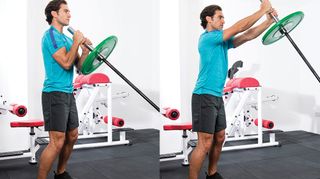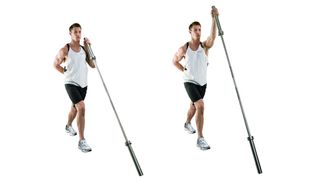How To Do The Landmine Press
Blow up your upper body with this angled barbell press

In a perfect world, we’d all be athletes – able to overhead press with zero pain and perfect form, maximising muscle with flawless body mechanics. But in the real world that’s trickier than it seems. “If you’re inflexible from your nine to five, keeping your shoulders in position while you press can be tough,” says trainer James Adamson. “Do them wrong and you can increase the strain on your rotator cuffs.”
Enter the landmine. Landmine exercises involve lifting, squatting or pressing one end of an angled barbell and they’re a worthy addition to any workout regime, but they’re especially good for those new to the weights room. That’s because they act as a stepping stone between unweighted versions of exercises like the squat and the full, loaded-barbell versions. By approaching the bar from a different angle, you’ll reduce the stress while still being able to load up for hypertrophy.
Some gyms will have a dedicated landmine, a device that you insert one end of a barbell in, but you can also do these presses with one end of a barbell pushed into a corner (we recommend wrapping the end in a towel or something similar to avoid marking the wall).
The landmine press is a great exercise for almost all of your upper body, with the chest, triceps and shoulders taking the brunt of the work. The curving path of the press and the neutral grip also make landmines presses slightly easier on the shoulders than vertical presses.
How To Do The Landmine Press
There’s no agreed standard for this exercise, so don’t be surprised if a PT asks you to do the landmine press differently to the way described here. The variations come down to doing the press standing or kneeling, and holding the bar with one hand or two. We’ll run through the form of two common standing landmine presses here, then detail more in the variations sections below. At least you won’t get bored of the landmine press in a hurry.

For the two-handed landmine press, stand holding the weighted end of the barbell with both hands in front of your chest. Make sure the barbell is wedged securely in a landmine device or corner. Your feet should be level and shoulder-width apart. Press the weight up with both hands until your arms are extended, then bring it back down slowly.

With the single-arm landmine press it’s best to adopt a split stance, with the opposite leg to the arm you are lifting with forwards. Press the weight up with one arm, keeping it in line with your shoulder rather than moving it towards the middle of your body. Single-arm landmine presses work the shoulder harder than two-handed presses, which are more focused on the chest.
Get the Coach Newsletter
Sign up for workout ideas, training advice, reviews of the latest gear and more.
See related
Landmine Press Variations
Kneeling landmine press
The motion involved in a landline press changes depending on how tall you are, because barbells don’t vary as much in their length as humans do in their height. If you are very tall the move is more like a flat or incline press than a vertical press. There’s nothing wrong with that, but if you want a more vertical-style lift, drop onto one knee (on the same side as the arm you’re pressing with) and perform the press. You can also do a two-handed press with both knees on the floor.
Landmine shoulder-to-shoulder press
Holding the barbell in both hands by one shoulder, with your feet level and shoulder-width apart, press the weight up and then bring it down to the opposite shoulder. This movement makes your core work harder to stabilise your upper body during the movement.
Single-arm landmine press with rotation
Start in a single-arm landmine press position, in a split stance with the opposite leg forwards. At the start of the movement your weight should be over your rear leg. Press up, turn your body and lift your back heel so your weight shifts forwards onto your front foot. Then rotate back down as you lower the weight. This version recruits your legs more and is a good way to build power throughout the whole body.
Landmine squat to press
Combine two key moves with this variation. Hold the end of the bar in both hands, squat down until your thighs are parallel to the floor, then stand up and press the bar overhead in one motion. The forward angle on the press reduces shoulder stress, and you don’t need a bar on your back.

Nick Harris-Fry is a journalist who has been covering health and fitness since 2015. Nick is an avid runner, covering 70-110km a week, which gives him ample opportunity to test a wide range of running shoes and running gear. He is also the chief tester for fitness trackers and running watches, treadmills and exercise bikes, and workout headphones.

How To Watch The London Marathon 2024 On TV Or A Live Stream

“The PBs Have Always Been Secondary, I Just Enjoyed Running”—How Anya Culling Took Two Hours Off Her First London Marathon Time

This Expert PT Recommends Kettlebell Training For Strength, Power And Cardio Gains—And These Are The Six Exercises To Master First